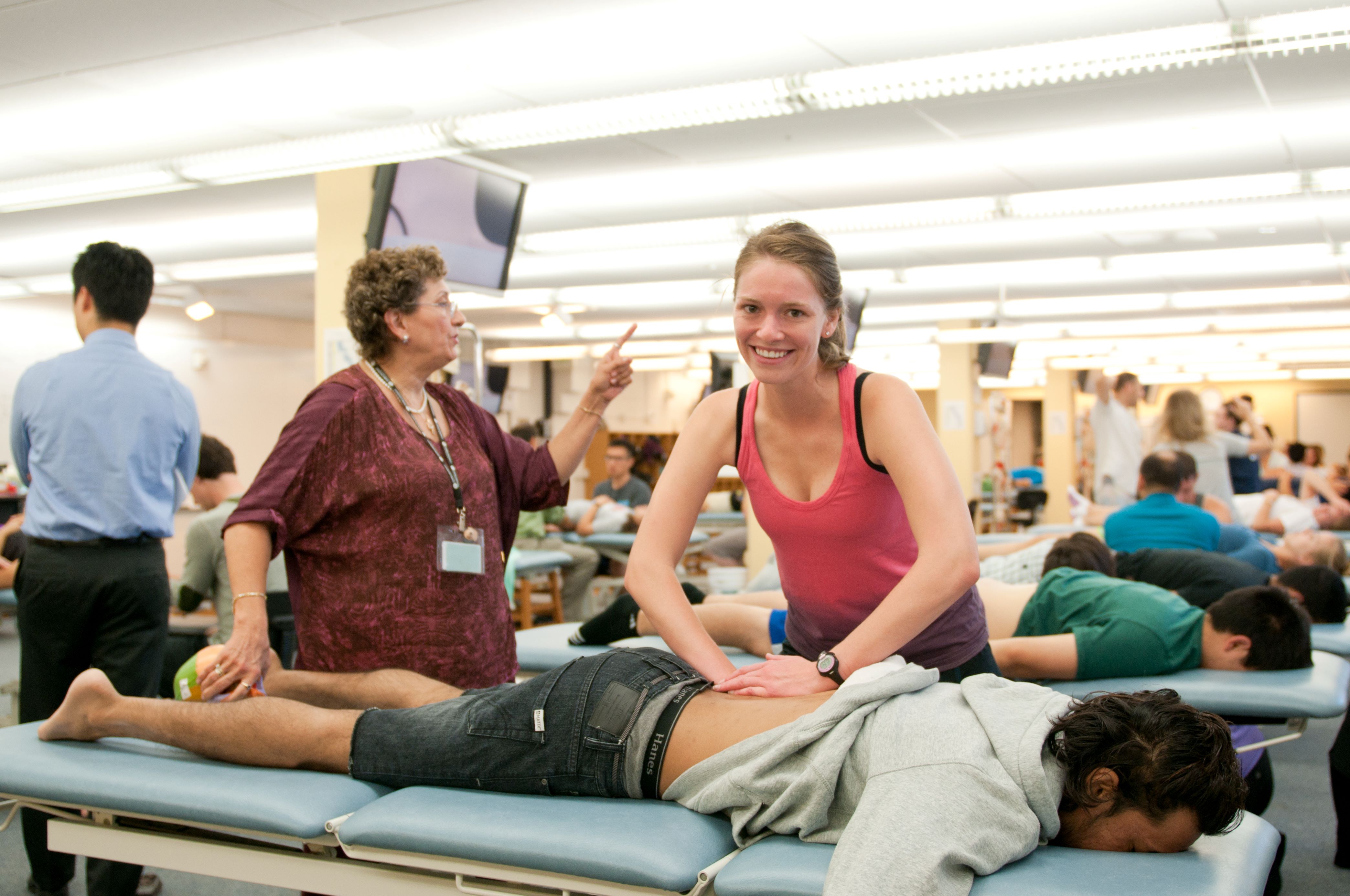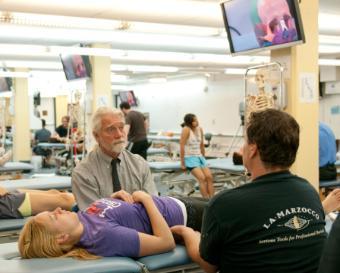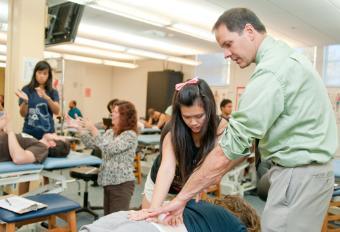What is Osteopathic Medicine
Osteopathic Medicine, Often Referred to As Osteopathy, is a Distinct Branch of Medicine that Emphasizes a Patient-Centered Approach to Healthcare

The osteopathy profession views the body as an interconnected whole and focuses on the relationship between the body's structure and its function. In the U.S., osteopathy is practiced by a Doctor of Osteopathic Medicine (DO) and may utilize Osteopathic Manipulative Treatment (OMT) which involves using the hands to diagnose, treat, and prevent illness or injury by manipulating, or adjusting, the body's musculoskeletal system with manual movement. It could be used in concert with medications or other treatments to treat a variety of health issues or used alone.
Difference Between a DO, MD, and MBBS Physician
Allopathic Doctors of Medicine (MDs), or Bachelor of Medicine Bachelor of Surgery (MBBS) in the UK have a lot in common with U.S.-trained DOs. The road to becoming a DO is built on similar scientific and clinical foundational elements, with a focus on more holistic care. Like MDs, DOs are licensed professionals working within the scope of evidence-based medicine. DOs are recognized as MD and MBBS equivalents in most of the world.
How is Osteopathic Medicine Different?
Osteopathic medicine is a branch of healthcare that places a strong emphasis on a patient-centered approach to medical practice. It views the human body as a complex, interconnected system and seeks to understand the relationship between the body's structure and its function. Osteopathic physicians, known as DOs, are fully licensed medical doctors who combine traditional medical training with osteopathic principles.
The philosophy of osteopathic medicine is characterized by several key principles:
Osteopathic medicine sees the patient as a whole, addressing not only their physical health but also considering the impact on mental and emotional well-being. This perspective guides the diagnosis and treatment of illness.
Osteopathic physicians believe that the body's structure and function are intimately linked. They assess the musculoskeletal system to identify any dysfunctions that may contribute to health issues.
Osteopathic medicine recognizes the body's natural tendency to heal itself when properly supported. Physicians aim to facilitate and enhance the body's inherent ability to recover from illness and injury.
Osteopathic Manipulative Treatment (OMT):
One of the distinctive features of osteopathic medicine is OMT, which involves the use of hands-on techniques by DOs to diagnose, treat, and prevent a wide range of medical conditions. These techniques include gentle stretching, pressure, and resistance, intending to improve musculoskeletal function, promote pain relief, and enhance overall well-being.
OMT can be used for various purposes, such as reducing pain, improving mobility, addressing issues like musculoskeletal injuries, and even providing relief from certain conditions like headaches, back pain, and so much more.
Emphasis on Prevention, Wellness, and the Body's Natural Tendency Towards Self-Healing:
Osteopathic medicine places a strong emphasis on preventive care. DOs work with patients to identify risk factors and develop strategies to maintain and enhance overall health. This preventive approach aligns with the belief that the body has a natural tendency to heal itself when given the right support.
Overall, osteopathic medicine is rooted in a patient-centered philosophy that considers the interconnectedness of the body, mind, and spirit and seeks to support the body's inherent capacity for healing and well-being through a combination of traditional medical practices and osteopathic principles.
Four Tenets of Osteopathic Medicine
There are four core tenets and philosophy of osteopathic medicine. Let's delve into each of them to understand their significance:
The Body as a Comprehensive Unit
Osteopathic medicine views the body as an integrated and interconnected whole. It recognizes that all the systems and components of the body, including the musculoskeletal, circulatory, nervous, and respiratory systems, are interdependent. In other words, the health of one part of the body can influence the health of other parts. This includes the natural connection between the mind, body, and spirit.
 Significance: This patient-centered perspective encourages DOs to consider the entire well-being of the body, not just the specific ailment or symptom. It fosters a comprehensive approach to healthcare that aims to address the root causes of health issues.
Significance: This patient-centered perspective encourages DOs to consider the entire well-being of the body, not just the specific ailment or symptom. It fosters a comprehensive approach to healthcare that aims to address the root causes of health issues.
The Body's Capability for Self-Regulation and Healing
Osteopathic medicine recognizes the body's innate ability to regulate and heal itself. The body has built-in mechanisms for maintaining health and repairing damage.
Significance: DOs focus on supporting the body's natural healing processes. This approach often emphasizes preventive measures, such as healthy lifestyle choices, to help patients maintain and improve their health.
The Interrelationship Between Structure and Function
Osteopathic medicine is built on the belief that the structure of the body influences its function and vice versa. When structural elements (such as bones, muscles, and connective tissues) are in proper alignment, they can promote optimal physiological function. Conversely, structural imbalances can lead to dysfunction.
Significance: This principle underscores the role of osteopathic manipulative treatment (OMT) in diagnosing and addressing structural issues. By realigning the body's structure, DOs aim to restore or enhance its natural functions and support the body's self-regulation and healing mechanisms.
Rational Treatment Based on Understanding the Body's Unity and Principles
Osteopathic medicine is grounded in evidence-based practice and scientific principles. DOs are trained to make treatment decisions based on a deep understanding of the body's unity, its capacity for self-regulation and healing, and the relationship between structure and function.
Significance: DOs use this understanding to guide their treatment approaches. They aim to provide rational and patient-centered care that addresses the underlying causes of health issues, promoting long-term well-being and health.
Overall, these principles collectively define the philosophy of osteopathic medicine. They emphasize a patient-centered and preventive approach to healthcare. DOs are trained to consider not only the symptoms but also the broader context of a patient's health, recognizing the body's remarkable ability to heal itself when given the right conditions and support. This philosophy guides DOs in delivering personalized and comprehensive care to their patients.
Whole-Person Care Approach
The whole-person care approach in osteopathic medicine underscores a patient-centered model of healthcare that values engaging with and listening to patients, looking beyond symptoms to understand lifestyle factors, and promoting natural healing. Here's a deeper exploration of these principles:
Patient-Centered Approach
Osteopathic medicine places the patient at the center of care. It recognizes that patients are unique individuals with distinct needs, values, and circumstances. As a result, the care provided by DOs is personalized, respectful, and collaborative.
Significance: This approach empowers patients to actively participate in their healthcare decisions. DOs strive to establish strong doctor-patient relationships built on trust, mutual respect, and open communication.
Engaging and Listening to Patients
DOs prioritize active engagement and attentive listening to their patients. They take the time to understand a patient's medical history, concerns, and goals. Listening attentively to a patient's narrative is considered an integral part of the diagnostic process.
Significance: Patient engagement and active listening allow DOs to gather essential information about the patient's health, lifestyle, and concerns. This deeper understanding enables more accurate diagnoses and patient-tailored treatment plans.
Looking Beyond Symptoms to Understand Lifestyle Factors
Osteopathic medicine encourages DOs to consider the patient's whole health. Instead of merely addressing symptoms, DOs examine the patient's lifestyle, social determinants of health, and emotional well-being. They explore how these factors may contribute to the patient's condition.
Significance: By considering the broader context of a patient's health, DOs can identify the underlying causes of illness and develop comprehensive treatment plans that not only manage symptoms but also promote long-term well-being. This approach is particularly beneficial for preventive care.
Reducing Medication and Promoting Natural Healing
Osteopathic medicine emphasizes reducing the reliance on medication when possible and promoting the body's innate capacity for natural healing. DOs aim to use pharmacological interventions judiciously and, where appropriate, advocate for non-pharmacological approaches.
Significance: This approach aligns with the principle of supporting the body's ability to self-regulate and heal. It can lead to a reduction in the use of medications, particularly for chronic conditions, and encourages patients to make lifestyle changes that support their health.
The goal of whole-person care in osteopathic medicine is to provide comprehensive, individualized, and patient-focused healthcare. DOs are trained to address not only the physical aspects of a patient's health but also take into consideration the emotional, social, and environmental factors that contribute to their well-being. This approach fosters patient empowerment, improves doctor-patient relationships, and the potential for more effective healthcare outcomes. It distinguishes osteopathic medicine as a patient-centered and integrative approach to healing.
Summary of Osteopathic Medicine
Osteopathic medicine offers a unique and patient-centered approach to healthcare that places it at the forefront of modern medicine. The key principles and values that underpin osteopathic medicine, including a comprehensive view of the body, the body's innate healing capacity, and a focus on understanding the interplay between structure and function, make it a distinctive and highly valuable field. Osteopathic medicine not only addresses the symptoms but also seeks to understand the root causes of health issues, empowering patients to achieve lasting well-being.
 Osteopathic medicine is characterized by:
Osteopathic medicine is characterized by:
- Whole-Person Care: A patient-centered approach that recognizes the individuality of each patient and prioritizes open communication, active listening, and a comprehensive understanding of the patient's health.
- Preventive and Natural Healing: A commitment to preventive care and a focus on promoting the body's natural ability to heal, which often results in reduced reliance on medication.
- Versatility: DOs are trained in various medical and surgical specialties, allowing them to provide a wide range of healthcare services.
- Community Service: A tradition of serving in underserved areas, community health centers, and rural communities, addressing healthcare disparities and improving public health.
If you are passionate about making a difference in people's lives, embracing a patient-focused approach to healthcare, and contributing to the well-being of communities, a career as a DO may be the ideal choice for you. Osteopathic medicine provides a distinctive and valuable perspective in the ever-evolving landscape of healthcare, and it offers the opportunity to be an integral part of a profession that continually seeks to improve the quality of life for all.
